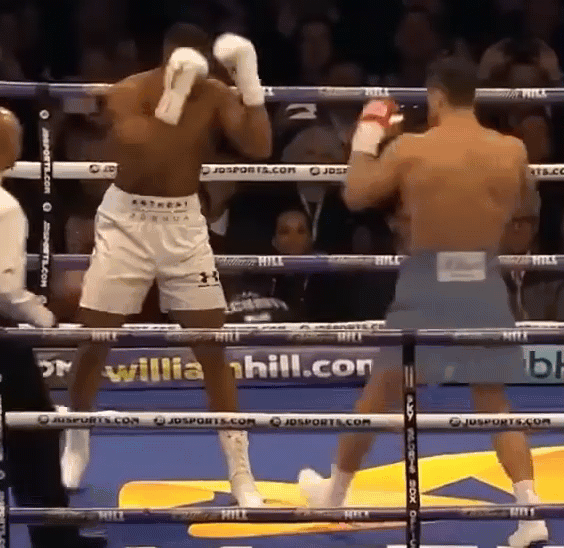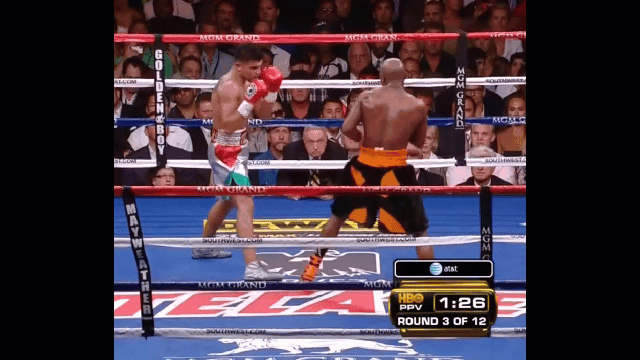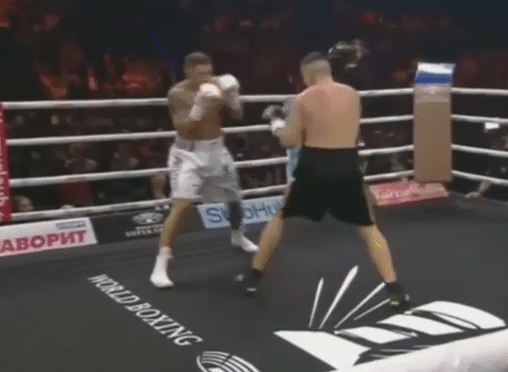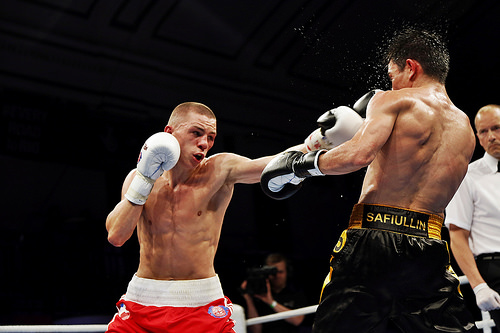In boxing, the jab is considered the most important punch. They say if you can’t establish the jab, you won’t land anything else. That adage says a lot about boxing defense, too: if you can shut down your opponent’s jab, you effectively shut down their offense (or at least reduce it to low-percentage Hail-Mary hay-makers thrown from too far out).
Today, we show you how to counter the jab in 8 different ways, using film study techniques to draw from Anthony Joshua’s epic win over Wladimir Klitschko:
Wait – do I really need to know how to counter the jab in so many different ways?
Bruce Le famously said: “I fear not the man who has practiced 10000 kicks once, but I fear the man who has practiced one kick 10000 times.” Doesn’t that apply to jab defense? Shouldn’t you hone one unstoppable jab counter, rather than splitting your focus on 8 or more?The truth is that there are dozens of other techniques you can use to shut down the jab, and they’re all worth adding to your arsenal. Consider these 8 as introductory material, and keep studying.
Why so many? Because there is no singular, “perfect” jab defense; you need options when fighting at a high level. Defending the jab with only 1 or 2 techniques makes you predictable, which makes you vulnerable to nasty set-ups. For example:
- If all you do is fade back (technique #1), I’ll feint you right into the ropes and go to work there.
- If I see you catching the jab (technique #2) every time, I can feint a jab and clobber you with a left hook.
- If all you do is pull back from my jab (technique #8), I’ll spear the next one into your body and follow up from there.
As you can see, every single boxing technique will expose you to a potential counter. There are pros and cons to every move you make in the ring. Knowing how to counter the jab one way just isn’t enough.One of the best ways to mitigate risk and minimize the openings your techniques leave is to vary your jab defense. Barry Robinson calls this “giving the guy different looks.” Your goal is to keep your opponent thinking and reactive, rather than comfortable and creative, and that’s what knowing how to counter the jab 8 ways does for you.Need more proof of concept? Consider this: all 8 of the following jab defenses occurred WITHIN THE VERY FIRST ROUND. Anthony Joshua cycled through every single one of these jab defenses in well under 3 minutes. That’s what it takes to shut down a jab as good as Klitschko’s, and that’s what we cover today.
How to Counter the Jab with Footwork
Footwork is the first line of defense against the jab, and it’s one of the best because it leaves your hands and head free to defend. Since this article is meant for beginners and intermediates, we’re going to leave pivots, foot feints, and switch steps for our advanced jab defense series.
1. Fade back
Backing out of range of the jab the moment it’s thrown is an easy way to frustrate an opponent who’s trying to get offense going. Sometimes called “fading,” this jab defense is intuitive, low-energy, and effective at every level.
 Joshua feints forward motion, then fades away from Klitschko’s jab. Klitschko must restart his offense.
Joshua feints forward motion, then fades away from Klitschko’s jab. Klitschko must restart his offense.
To fade away from the jab, simply take a basic backwards step using proper footwork. At this stage, that’s really all there is to it; so long as you act early enough, and the step you take out is longer than the step your opponent took in, their jab won’t reach you.
Fading away is a safe jab defense is because it keeps so many defensive “systems” active at once. Since your feet are doing all the work, your hands are free to block or parry in case you misread distance or timing. You’re also free to slip, bob, and weave, which is all made easier since extra space leaves more time to react to punches. As you can see in the clip above, Joshua fades with great balance, posture, hand position, and eye contact – he’s ready for anything! Broadly speaking, fading is best used after a feint that baits your opponent into jabbing – put them on your time, make them miss, then fight on your terms. Understand that the defensive benefits of fading come at a cost: by moving away from the opponent, you add travel time to any counter punches. This makes the fade more safety-first than offensive-minded, even with the openings you create by getting your opponent to reach. Resist the urge to lunge back in to exploit these openings unless you’ve got a serious edge in speed, stamina, or experience.Fading isn’t foolproof, especially against hard-charging opponents, since most people can move straight forward with punches faster than they can move straight back. For this reason, fading should only be used intermittently – if you get predictable, expect some nasty cloak-and-dagger style setups coming your way. If you fade back from the jab, keep your eyes on target and be ready to move off-line or transition to other defensive techniques immediately.Be very careful about fading twice in a row.Of course, as with all the techniques shared today, fading can be used in conjunction with other jab counters. Common combinations include:
- Fade and catch the jab
- Fade with high guard/pillar block
- Fade with hands extended for trapping/proactive parries
- Fade with slip or other evasive head movement
How to Counter the Jab with Parries/Hand Control
Parries are higher up on boxing’s defensive hierarchy than blocks because 1) they’re better at dissipating the force of the punch; 2) they give you control of the opponent’s glove; and 3) because glove-on-glove contact gives the range-finding benefits of probing punches.
2. Catch the jab (rear hand “short parry”)
“Catching” or parrying the jab with the rear hand is a fundamental jab defense. When used properly, the rear hand parry is safe, reliable, and perfect for setting up all sorts of counter punches.
Because it starts from the guard and stays relatively close to the face, the jab catch is sometimes referred to as a “short parry.”
 Joshua catches Klitschko’s jab and fades back. Note the lead hand position and constant eye contact.
Joshua catches Klitschko’s jab and fades back. Note the lead hand position and constant eye contact.
How to catch the jab:
- Emphasize small movement. Your rear hand will travel no more than 3-4 inches from the face, moving from the standard guard position beside the chin to obstruct the jabbing lane (i.e. the path their jab travels).
- Meet the punch – don’t reach. Do not reach for the jab; let it come to you.
- Open the glove. Extend the fingers and turn your palm towards the opponent like a baseball mitt, looking to “catch” the jab and redirect its force.
- Turn your thumb. Focus on your thumb position – the thumb begins facing you, then makes a 90-degree turn to face your lead shoulder – to maximize the surface area of your parrying “shield.”
- Gently redirect the force of the punch. Most jab catches involve lightly tapping the jab down to send it off-course, but multi-directional parries are definitely worth learning.
- Recover. Immediately return the parrying hand to the standard guard position.
Catching the jab is relatively safe because the movement is so small. Moving your hands to obstruct the jab lane leaves you open for the hook, but the minimal amount of commitment involved makes it easy to recover your guard or move your head. As always, keep your defensive radar updated at all times, staying aware of what gaps you open as others close, and you’ll be fine.Since catching the jab involves making contact with the opponent’s gloves, this form of jab defense also gives you all the distance control and range-finding benefits of probing punches.
And if you like counter-punching, you’ll love the jab catch, as there are plenty of high-percentage options to choose from with either hand. Some old favorites include:
- Catch, jab (head or body)
- Catch AND jab (simultaneously impact)
- Catch, double-jab
- Catch, hook
- Catch, lead uppercut
- Catch AND cross (start the hips rotating for the parry, then follow-through with the same side the moment you get on top of the glove)
Like any other jab defense, catching has its drawbacks. In order to parry, you must take your hand away from the face, which creates an opening. If you parry too often – or worse, too big – smart opponents will feint your hands out of position, and make you pay for it.
3. Obstruct the jab lane (“proactive” parrying)
When beginners first learn how to parry punches, they’re taught the reactive method. As its name suggests, this method involves acting in response to the opponent’s punch – they throw the jab, you parry it off as described in point #2.
Reactive parrying is a fundamental defensive skill, but it’s not the only way to parry. As you search for ways to enhance your defense down the line, consider adding proactive parries to your game.
“Proactive parrying” refers to when a fighter uses the parrying motion before their opponent punches. In this case, we’re referring to the same jab catch parry motion covered in the previous point.Parrying before any punches are thrown may sound stupid – you literally “parry” the empty space in front of you – but taking the initiative in this way offers a number of offensive and defensive benefits discussed in detail in our parrying breakdown.
 Joshua obstructs Klitschko’s jabbing lane, proactively parrying the punch.
Joshua obstructs Klitschko’s jabbing lane, proactively parrying the punch.
To counter an opponent’s jab before it’s thrown, use the same jab catch motion described earlier, only this time linger in that “jabbing lane” a little longer. Your goal here is obstruction; place traffic in the lane your opponent’s jab would travel through to discourage them from throwing the shot. If they do jab, all the better – work one of the parry counters listed previously. But so long as your hand is in the catching position, their jab won’t be available. Automating your jab defense in this way frees up your mental resources to deal with remaining threats more effectively.
Of course, proactive parries leave you open to the same shots as reactive ones. For this reason, proactive parries should be kept short, though the hand can stray a little further from the face if its being done consciously. As with any rear handed parry, stay on the lookout out for the hook!
4. Parry with the lead hand (“long parries,” lead hand control)
Lead hand control is a multifaceted concept that refers to a broad range of offensive and defensive tactics that make up a larger cloak and dagger fighting system, but for the purposes of this article we’re talking specifically about long jab parries with the lead hand.
BELOW: Joshua parrying the jab with the lead hand on two occasions in Round 1:


Lead-hand parries are great because they stop the opponent’s punch before it has a chance to really get started. This makes redirecting the punch much easier than it would be if it had the force of full extension behind it. Since they occasionally look like jabs themselves, long lead-hand parries also work as feints, and they offer all the same distance-control benefits of probing punches.Unlike the rear-hand jab parries highlighted in points #2 and #3, lead hand jab parries are designed to reach towards the opponent. To that end, they’re generally only used at long range, where the opening left by your cross-parry can’t be exploited as fast.
In the above GIF, Joshua is far enough away that Klitschko’s right cross won’t catch him off guard. Any time Klitschsko tries to advance into cross range, Joshua steps back, using the extended hand as a measuring stick and “ten-foot pole” to back Klitschko off. There is a secondary defensive benefit of the cross-parry: the forearm lift or “elbow parry.” If Klitschko had tried to follow-up with a cross over top of Joshua extended left arm, Anthony could have scooped it up and off-course by spiking his forearm/elbow upwards. In this way, the lead hand serves double-duty, forcing the opponent to fight past two lines of defense.

Mayweather uses the forearm lift parry to stop a southpaw right jab. In orthodox vs. orthodox match-ups, this technique can be used to disrupt the right cross off a lead-hand parry.
5. Trap the jab hand
Borrowing from traditional martial arts, trapping refers to pinning the opponent’s glove in place, often in the guard position, to prevent that hand from punching. Taking a more offensive stance, Black Belt Magazine defines trapping as “the momentary immobilization of an opponent’s limbs designed to give you a brief opportunity to strike while he cannot.”
 Joshua covers Klitschko’s glove with his lead hand, nullifying the punch with a classic “trapping” technique.
Joshua covers Klitschko’s glove with his lead hand, nullifying the punch with a classic “trapping” technique.
Like obstructing the jab lane, trapping is a proactive jab defense that works best when your opponent is already shelling up and you want to keep him that way. Use your trap before the opponent jabs, or within the first 20% of its extension.It is extremely frustrating to be on the receiving end of a trap, as your only option is to fight gravity and your opponent’s glove or disengage entirely. Though only applicable in the right circumstances, transitioning from a long parry into trapping is a great way to proactively counter the jab. A simple and effective approach is to trap when your opponents hands are in guard, then switch to parries any time they try to punch. Trapping also makes the transition from offense to defense easy. Since you’re already making contact with the opponent’s glove to keep the jab in its holster, it’s very easy to use that contact point to pry open the guard, ala Vasyl Lomachenko:

Lomachenko transitions from probing punches to pries, opening up Koasicha’s guard.
How to Counter the Jab with Head Movement
Knowing how to counter the jab with head movement is ideal because 1) you absorb no force; 2) denying your opponent contact disrupts their range-finding; 3) missing punches tires the opponent; 4) you load up big counter-punches; and 5) your hands and feet stay free to work.
6. Slip outside the jab
When learning basic head movement, most beginners start by slipping the jab to the outside. Slipping outside the jab keeps you safe from the cross, and opens up a slew of power-hand counters for orthodox fighters. This fundamental jab defense belongs in every fighters’ arsenal.

Joshua slips Klitschko’s jab to the outside and counters with a short right hook to the ribs.
To slip the jab to the outside, bend the knees, then turn the hips and shoulders towards your rear foot just enough to move your head off-line, about the width of a glove. Keep your eyes on target and make the movement as small as possible for faster counter punching.
7. Slip inside the jab
In orthodox vs. orthodox match-ups, the inside slip is a lot scarier than the outside slip because it takes you across the path of the opponent’s path hand. But when properly executed, this slip is great for sneaking in quick uppercuts, hooks, and body punches.

Joshua slips the jab to the inside, then ducks Klitschko’s follow-up overhand.
Because the inside slip takes you across the rear hand’s firing line, the movement should be kept small, leaving you balanced and in position to follow-up or pivot out as needed.
The body mechanics for an inside slip look a lot like a standard cross. Your hips, shoulders, and rear foot will move the same way, only the rotation will be more conservative, with less turn-over than you’d normally use, and a slightly exaggerated head-slot change. As with the outside slip, the head movement should only move enough to clear the punch – any excess movement only slows your counter punch. In the clip above, we see the “right cross” body mechanics in play, but Joshua’s head barely moves, amounting to little more than the turn of the cheek.
8. Pull back from the jab
Floyd Mayweather is the master of the pull counter in modern boxing, but you don’t have to be “TBE” to make this fundamental technique work.
Similar to the fade, the pull involves moving directly away from the jab, only the emphasis is on the upper body rather than the feet. It is a relatively safe move that is easily combined with blocks, hand-parries, and fading movement to add layers to your jab defense.

Joshua combines a pull with a jab catch to shut down Klitschko’s left hand.
To pull back from the jab, drive off the lead foot and shoot the hips forward to yank the upper body backwards. Depending on your range and the opponent’s reach, you may want to step with the back leg. Keep the chin tucked into the chest at all times. Mayweather likes to set his pulls up by leaning some weight onto the front foot/hip, which dangles his head out as bait and also makes it easier to drive weight onto the back foot.
BONUS: Drop under the jab
The simplest head movement you can use to counter the jab is to drop straight down. If they’re aiming at your chin, this easy level-change will send the jab soaring over your head, and leave you in prime position for uppercut counters.
For best results, don’t think about squatting – that’s too slow. Instead, drop straight down as though you were falling, then “catch yourself” with knees bent. In other words, you want to drop into the squat rather than lowering yourself into it.
We’re calling this a “bonus” clip because it falls outside our Joshua/Klitschko film study. Here we see Oleksandr Usyk dazzle Marco Huck with defensive movement, combining a high guard and level change to keep himself safe from the jab:

Wrapping Up
If you can’t defend the jab, you’re going to have a short and painful fight career. The same is true if you only have one or two defensive techniques in your arsenal.
Strive to expand your toolbox even as you continue to master those techniques you already know. Give different looks and stay unpredictable.
On behalf of the Warrior Punch team, I hope these 8 techniques for better jab defense help you on your martial arts journey!
If you have any additional questions about how to counter the jab, or would like further information about the video resources shared here, send us a message on Facebook.
photo credit: World Series Boxing WSB Semi-Finals – British Lionhearts vs Astana Arlans Kazakhstan Leg 2 via photopin (license)
